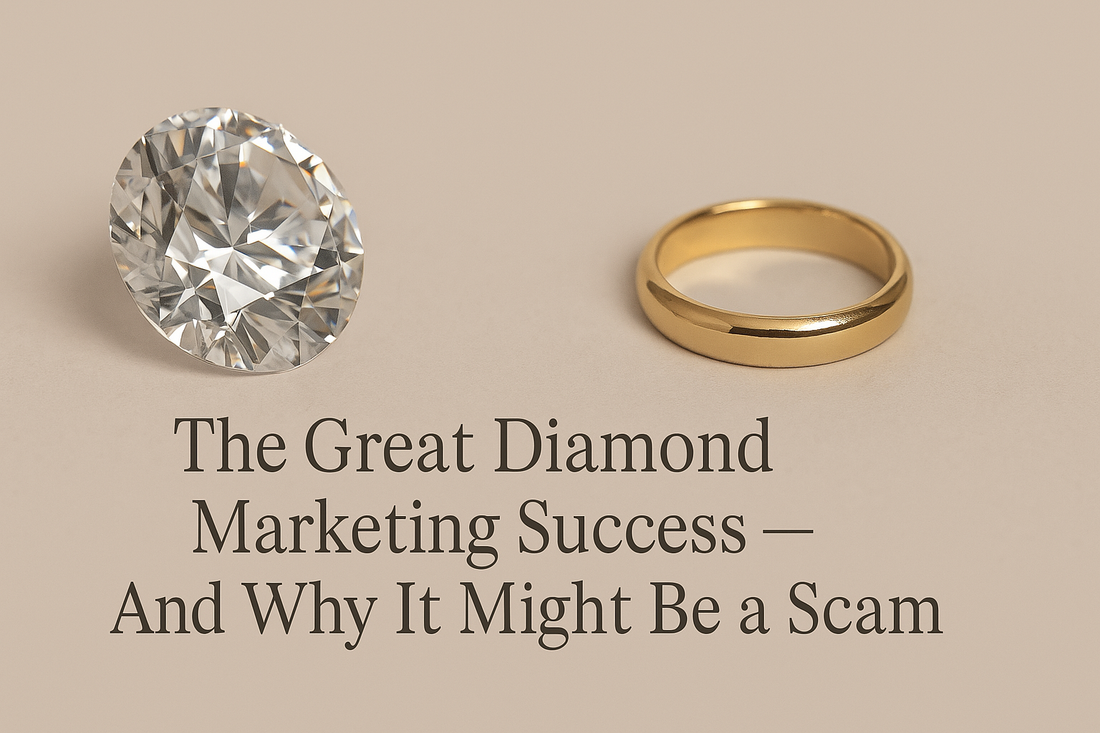
The Great Diamond Marketing Success – And Why It Might Be a Scam
Share
For decades, diamonds have been positioned as the ultimate symbol of love, status, and wealth. But have you ever stopped to ask why? Unlike gold, which has been treasured for its intrinsic value for thousands of years, diamonds owe much of their desirability to one of the most successful marketing campaigns in history.
So, are diamonds truly rare and valuable? Or have we all been sold a very expensive illusion? Let’s break it down.
How Diamonds Became "Forever" – A Genius Marketing Move
Before the 1940s, diamonds weren’t the default choice for engagement rings. In fact, other gemstones like sapphires, rubies, and emeralds were just as popular, if not more so.
Then came De Beers.
The De Beers diamond cartel wasn’t just a diamond company—it was an industry powerhouse that controlled supply, pricing, and perception. In 1947, they launched what would become one of the most influential advertising campaigns of all time with the slogan:
"A Diamond is Forever."
With this, De Beers achieved three things:
- Made diamonds synonymous with love and commitment.
- Created the idea that diamonds should never be resold. This kept the secondhand market weak, ensuring continued demand for new diamonds.
- Pushed the "two months' salary rule" as the "correct" amount to spend on an engagement ring—despite it having no real historical or financial basis.
This campaign rewired consumer behaviour so effectively that today, most people don’t even question why diamonds are the standard for engagement rings.
Are Diamonds Actually Rare?
One of the biggest selling points for diamonds is that they are rare—but in reality, they’re not nearly as scarce as their price suggests.
Here’s the truth:
- Diamonds are only "rare" because supply is artificially controlled. Mining companies like De Beers historically stockpiled diamonds to limit availability, keeping prices high.
- Unlike gold, which is a finite resource with industrial applications, diamonds exist in massive quantities but are released into the market strategically to maintain their illusion of exclusivity.
- While large, flawless diamonds are indeed rare, most commercial-grade diamonds are abundant—yet they are still priced at thousands of dollars per carat.
Diamonds vs. Gold – Which Holds Real Value?
A gold ring and a diamond ring might cost the same at purchase—but what happens when you try to sell them?
- Gold has intrinsic value. It is a globally recognized precious metal, used in investment, technology, and jewelry. If you need to liquidate gold, you can sell it based on live gold prices.
- Diamonds, on the other hand, lose significant resale value immediately. If you try to resell a diamond ring, you’ll often get only 30-50% of what you paid, unless the diamond is exceptionally rare.
- Gold prices have risen significantly over time. Diamonds, on the other hand, have not appreciated at the same rate—especially now that lab-grown diamonds are saturating the market.
Bottom Line: If you’re looking for a jewelry piece with lasting value, solid gold is the smarter choice.
Lab-Grown Diamonds: The Disruptor of the Industry
The rise of lab-grown diamonds has further exposed the flaws in the natural diamond pricing model.
What are lab-grown diamonds? They are physically, chemically, and optically identical to mined diamonds—but because they aren’t constrained by artificial scarcity, they cost 40-70% less.
What does this mean for the traditional diamond industry? It highlights what critics have said for years: diamonds have always been overpriced. If science can produce an identical diamond for a fraction of the cost, then why are mined diamonds still so expensive?
For many consumers, the illusion of rarity is fading, and lab-grown diamonds are becoming the logical choice for those who still want the sparkle without the markup and ethical concerns.
So, Are Diamonds a Scam?
Let’s be clear: wanting a diamond isn’t wrong. Many people love them for their symbolism, beauty, and tradition. But from an economic standpoint, the diamond market is one of the most successful cases of artificial value creation in modern history.
If you love diamonds, buy them—but do it with awareness. Just like luxury handbags, high-end watches, and designer goods, diamonds are a luxury product, not an investment.
Want Gold Jewellery Without the Luxury Markups?
At Bijouterie Minted, we specialize in solid 18k gold jewelry, priced by weight—not hype. While other brands inflate costs with brand names and artificial pricing strategies, we focus on real value, transparency, and timeless design.
Ready to invest in gold jewelry that actually holds value?
